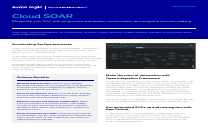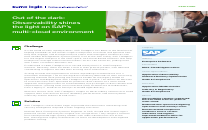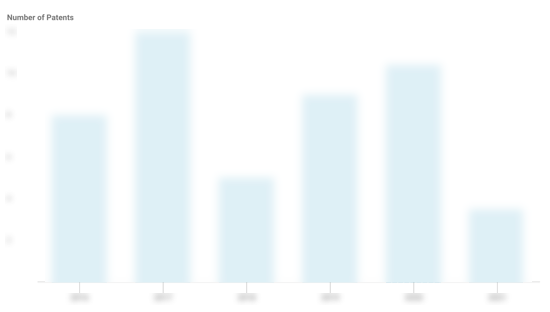
Sumo Logic
Founded Year
2010Stage
Take Private | AliveTotal Raised
$345.5MValuation
$0000Mosaic Score The Mosaic Score is an algorithm that measures the overall financial health and market potential of private companies.
-8 points in the past 30 days
About Sumo Logic
Sumo Logic is a company that offers cloud log management and security information and event management (SIEM) tools within the cloud computing industry. The company provides a SaaS platform that uses artificial intelligence and machine learning for log analytics, infrastructure monitoring, application performance monitoring, and security services. Sumo Logic serves sectors that require cloud security and observability, including education, financial services, fintech, gaming, manufacturing, public sector, and retail. It was founded in 2010 and is based in Redwood City, California.
Loading...
Sumo Logic's Product Videos


ESPs containing Sumo Logic
The ESP matrix leverages data and analyst insight to identify and rank leading companies in a given technology landscape.
The infrastructure monitoring market focuses on solutions for gaining visibility across IT environments. Infrastructure monitoring typically involves tracking the performance and health of IT components and applications, as well as resolve issues. These solutions enable observability by collecting data that is captured in metrics, logs, and visualizations. Many companies in this market provide AI-…
Sumo Logic named as Outperformer among 13 other companies, including IBM, Datadog, and Elastic.
Sumo Logic's Products & Differentiators
CloudSOAR
Modernize your SOC with progressive automation, orchestration, and insightful decision making for faster response times.
Loading...
Expert Collections containing Sumo Logic
Expert Collections are analyst-curated lists that highlight the companies you need to know in the most important technology spaces.
Sumo Logic is included in 3 Expert Collections, including Tech IPO Pipeline.
Tech IPO Pipeline
568 items
Conference Exhibitors
5,302 items
Cybersecurity
10,052 items
These companies protect organizations from digital threats.
Sumo Logic Patents
Sumo Logic has filed 59 patents.
The 3 most popular patent topics include:
- data management
- computer security
- computer network security

Application Date | Grant Date | Title | Related Topics | Status |
|---|---|---|---|---|
11/15/2022 | 10/1/2024 | Rotating disc computer storage media, Computer storage media, Video game storage media, Storage media, System administration | Grant |
Application Date | 11/15/2022 |
|---|---|
Grant Date | 10/1/2024 |
Title | |
Related Topics | Rotating disc computer storage media, Computer storage media, Video game storage media, Storage media, System administration |
Status | Grant |
Latest Sumo Logic News
Oct 23, 2024
By John Visneski , CISO at Sumo Logic John Visneski, Sumo Logic’s CISO, provides guidance on how companies can identify the best AI security solutions for their needs. This article originally appeared in Insight Jam , an enterprise IT community that enables human conversation on AI. Imagine a company eagerly investing in a “cutting-edge” AI-powered security tool that promises to revolutionize its Security Operations Center (SOC) through autonomous threat detection and response. The company, lured in by flashy marketing materials, implements the tool expecting significant improvements in efficiency and cost-savings. Only months later does the company discover that the tool is a glorified automation script with no true AI capabilities. No meaningful savings materialize, security vulnerabilities persist, and a preventable breach damages the company’s reputation. Unfortunately, this scenario is not unique; it’s a classic case of AI washing, which has been plaguing the security industry and gaining more recognition with the advent of generative AI. What is AI Washing? AI washing refers to the marketing practice of overstating or outright fabricating the role of AI in their products to make them seem more advanced or cutting-edge than they are. This practice is particularly rampant in the security space, with many vendors promising AI-powered solutions that can automate threat detection, network monitoring, incident response, or vulnerability management. For example, imagine buying a junker car marketed as brand new. You expect it to drive smoothly, but soon enough, the car is constantly breaking down, leading to unexpected repair costs and a loss of trust in the dealership that sold you the vehicle. Similarly, companies invest in overhyped AI tools without understanding their true capabilities, leading to costly missteps. As AI developments continue to attract global attention, more companies are eager to claim their technology is AI-enabled—whether it is or not. Buyers seeking AI products must watch out for exaggerated claims and maintain a methodical approach to vetting potential solutions. The Pitfalls of Falling for the Hype For companies that fall victim to AI washing, consequences typically come from operational inefficiencies, wasted capital, and exploitable vulnerabilities. AI-washed capabilities often force teams to revert to manual threat management, creating unexpected workload and labor cost increases. These tools may also miss threats altogether, exposing the organization’s infrastructure to easily avoidable breaches. Given all of this, how can businesses protect themselves from AI washing? The key lies in asking the right questions, diving into the tech and the data behind it, and approaching the new world of AI with a healthy dose of skepticism. Here are three critical strategies for organizations to consider when weighing AI options. 1) Follow the Data AI thrives on data. Large, well-trained large language models (LLMs) require immense amounts of data to function effectively, making the quantity and quality of available data available critical to a vendor. Vendors like AWS, Google, and Microsoft have the advantage of vast data lakes, enabling them to build and refine comprehensive AI tools effectively. On the other hand, unless smaller vendors are working with partners, they often don’t have access to the quantity of quality data necessary to build effective AI solutions. When evaluating solutions, ensure the vendor has a sufficient and diverse data set to train their AI model. 2) Have Data Scientists on Staff When evaluating AI vendors, a strong indicator of the solutions’ authenticity and quality is the composition of their teams. While many startups offer innovative approaches, be sure to vet them carefully. Ensure the vendor has AI experts directly involved in product development, providing the critical expertise needed to enhance the solution. Beyond leadership, look for a dedicated team of data scientists or AI engineers who have experience working with AI tools and large data sets. Vendors relying solely on developers without specific AI expertise are more likely to offer AI-washed solutions. A team with this depth of expertise can better assess and validate the capabilities of their AI technology, ensuring you’re choosing a genuinely AI-powered solution. 3) Ask for Proof Don’t take a vendor’s word at face value. Request white papers, case studies, and metrics that demonstrate that the solution is performing as marketed. While vendors might be hesitant to show proof due to proprietary information, it’s essential to feel confident that the AI solution in question will accomplish the desired objectives before purchasing. Be sure to thoroughly review any shared materials before signing any agreement to validate that the product can deliver on its promises. Avoiding the Pitfalls of AI-Washed Solutions Unintentionally investing in AI-washed solutions can have severe consequences and prevent organizations from achieving their cybersecurity goals. Organizations may find themselves overpaying for lackluster technology, only increasing analyst burnout and leaving critical vulnerabilities unprotected. AI, like machine learning, has already improved how our security teams respond to threats today. The hype is real, but it’s important to remain realistic. The key to navigating the world of AI-powered security solutions and claims is vigilance. By looking at AI solutions with a skeptical eye and identifying the gaps between marketing promises and reality, security professionals can avoid the costly mistake of investing in over-hyped, AI-washed solutions. Share This Tags
Sumo Logic Frequently Asked Questions (FAQ)
When was Sumo Logic founded?
Sumo Logic was founded in 2010.
Where is Sumo Logic's headquarters?
Sumo Logic's headquarters is located at 305 Main Street, Redwood City.
What is Sumo Logic's latest funding round?
Sumo Logic's latest funding round is Take Private.
How much did Sumo Logic raise?
Sumo Logic raised a total of $345.5M.
Who are the investors of Sumo Logic?
Investors of Sumo Logic include Francisco Partners, Institutional Venture Partners, Tiger Global Management, Franklin Venture Partners, Battery Ventures and 9 more.
Who are Sumo Logic's competitors?
Competitors of Sumo Logic include Splunk, Devo, Securonix, CloudWize, Logz and 7 more.
What products does Sumo Logic offer?
Sumo Logic's products include CloudSOAR and 3 more.
Who are Sumo Logic's customers?
Customers of Sumo Logic include SAP, Grammarly and Pokemon.
Loading...
Compare Sumo Logic to Competitors

New Relic develops cloud-based software. The company provides solutions to track and provide insights on the performance of websites and applications. It serves e-commerce, retail, healthcare, media, and other industries. The company was founded in 2008 and is based in San Francisco, California.
observIQ specializes in telemetry and observability within the technology sector, offering a unified platform for managing telemetry data. The company provides solutions to reduce observability costs, optimize data routing, and manage telemetry agents, catering to the needs of modern observability teams. Its services are designed for enterprises looking to analyze, reduce, and manage their data, with a focus on reducing log volume, standardizing on open source standards, and ensuring enterprise scalability. It was founded in 2020 and is based in Grand Rapids, Michigan.
observIQ specializes in telemetry and observability within the IT monitoring sector. It offers solutions to help reduce observability costs, manage telemetry data from various sources, and engage in the management of agent fleets. observIQ primarily serves sectors that require robust IT monitoring and data management, such as cloud computing and enterprise IT infrastructures. observIQ was formerly known as Blue Medora. It was founded in 2020 and is based in Grand Rapids, Michigan.

Devo specializes in cloud-native security analytics and serves as a foundational platform for security operations. The company offers a suite of services including a security information and event management (SIEM) system, security orchestration, automation and response (SOAR), and user and entity behavior analytics (UEBA), all aided by artificial intelligence and intelligent automation to facilitate real-time decision-making. Devo was formerly known as Logtrust. It was founded in 2011 and is based in Cambridge, Massachusetts.

Grafana Labs specializes in open observability platforms for monitoring and visualizing operational data across various industries. The company offers solutions for log aggregation, data visualization, distributed tracing, and metrics backend, enabling users to monitor and analyze their operational performance. Grafana Labs provides both fully managed cloud services and self-managed enterprise solutions to cater to different customer needs. Grafana Labs was formerly known as Raintank. It was founded in 2014 and is based in New York, New York.

Sysdig provides security for cloud-based systems, containers, and Kubernetes. The company offers a platform that helps detect threats, manage vulnerabilities, control risks across multiple cloud environments, and manage permissions. It primarily serves the cloud computing industry. It facilitates vulnerability management, posture management, cloud monitoring, custom metrics, and more. Its products are Sysdig Platform and Sysdig Monitor. It was formerly known as Draios. It was founded in 2013 and is based in San Francisco, California.
Loading...